The Radeon R9 280X Review: Feat. Asus & XFX - Meet The Radeon 200 Series
by Ryan Smith on October 8, 2013 12:01 AM ESTCompany of Heroes 2
Our second benchmark in our benchmark suite is Relic Games’ Company of Heroes 2, the developer’s World War II Eastern Front themed RTS. For Company of Heroes 2 Relic was kind enough to put together a very strenuous built-in benchmark that was captured from one of the most demanding, snow-bound maps in the game, giving us a great look at CoH2’s performance at its worst. Consequently if a card can do well here then it should have no trouble throughout the rest of the game.
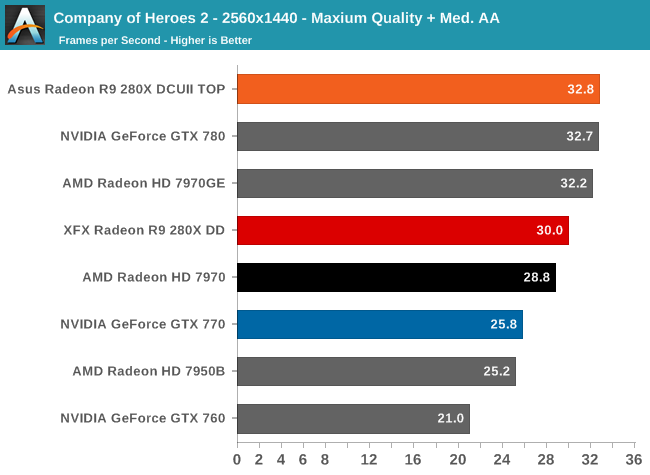
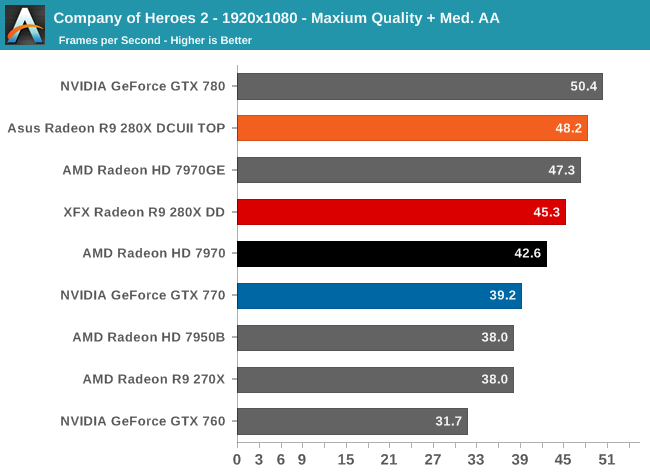
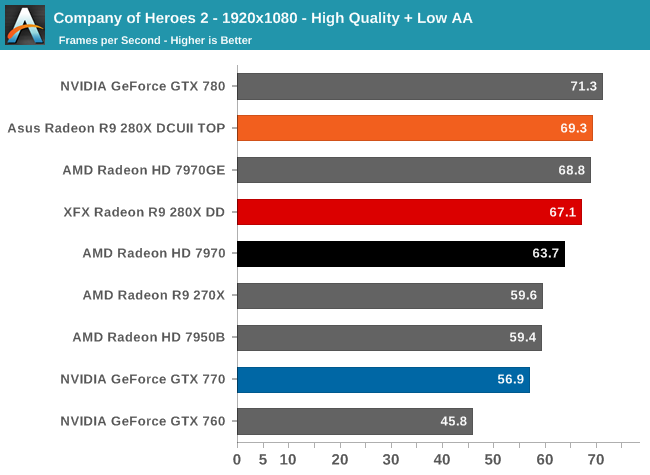
Like Metro this is the first time we’ve deployed this benchmark in a review. The results as it turns out are extremely good for AMD, with the reference clocked 280X surpassing the GTX 770 by over 16%. Given the price disparity between the cards simply tying the GTX 770 would be a good outcome, so surpassing it is even better. Of course this is basically a best case scenario, so not every game will see a lead like this.
On a side note, it’s mildly amusing to see that the 280X delivered 30fps on the dot. For an RTS game that’s a perfectly reasonable average framerate, so the 280X ends up being just fast enough to deliver the necessary performance for 2560 in this game.
Finally, on a lark we threw in the GTX 780 results, primarily to visualize the gap between the GTX 780 and its half-priced competition in preparation for the launch of the 290X. Never did we expect to see a 280X card top the GTX 780, but sure enough that’s what happens here, with the Asus factory overclocked 280X passing the GTX 780 by 0.1fps. This isn’t really a fair comparison due to the factory overclock, but it’s interesting none the less to see a Tahiti card keep up with GTX 780.
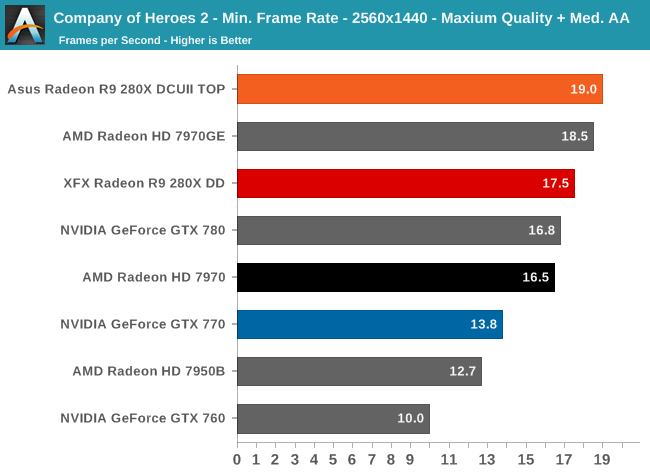
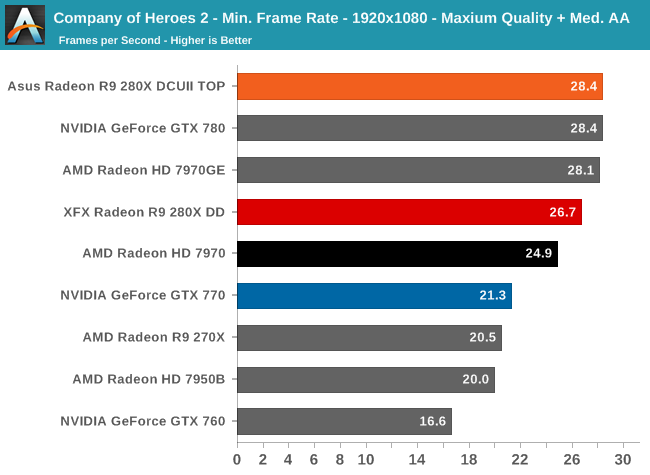
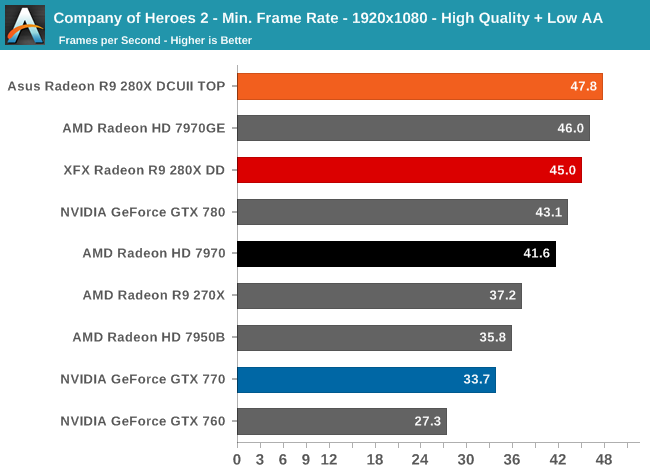
CoH2 also gives us a reliable look at minimum framerates, which like the average framerate over the whole benchmark appears to be entirely GPU bound. The 30fps average for the 280X at 2560 may be playable, but players sensitive to dips in the framerate will not appreciate these minimums. To get the minimum framerate about 30fps we have to go all the way down to 1080p at high quality.
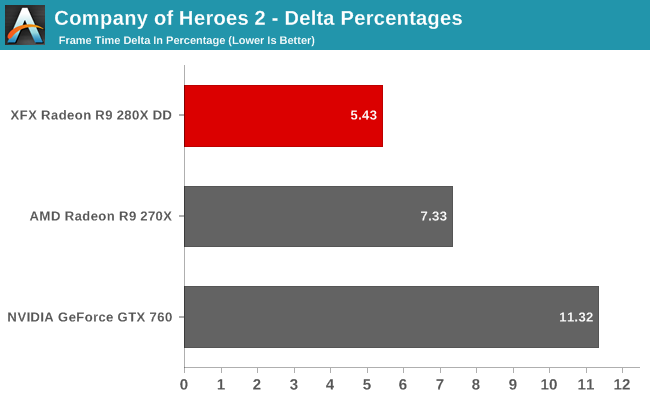
Finally, while we didn’t have time to collect FCAT results for every card we were able to collect limited FCAT results for the most important cards. With our delta percentages method we’re looking for sub-3% frame time deltas for single-GPU cards, which is actually something that everyone has trouble with in CoH2. What the minimum frametimes hint at is that this game has a periodic frame time spike to It, that although it won’t be a problem for RTS gameplay, will similarly set off players sensitive to changes in frame times. This appears to be the work of the game and benchmark itself, as all of our cards struggle here in a similar manner.










151 Comments
View All Comments
nathanddrews - Tuesday, October 8, 2013 - link
GTX700 = GTX770, derp.Da W - Tuesday, October 8, 2013 - link
Sure. Just go to your job every day and work hard just to give free stuff at people.nathanddrews - Tuesday, October 8, 2013 - link
Who said anything about giving "free stuff at people"? I'm talking about competitive pricing - the NVIDIA lineup is overpriced.Mondozai - Tuesday, October 8, 2013 - link
Speaking of which, we could use an edit function ;)Mondozai - Tuesday, October 8, 2013 - link
Nah, they are more logical now. People are just bitching because their head hurts when re-adjusting.JPForums - Tuesday, October 8, 2013 - link
So, the 280X is a 7970(not quite)GHz edition that is not quite price competitive with overclocked 7970s that give you essentially the same thing.The 270X is a 7870 with a token boost clock and better memory bandwidth. Unfortunately it is priced $20 ($50 w/MIR) more expensive than the generally more powerful 7870XT.
The 260XT is a 7790 with a somewhat meaningful boost clock. Too bad it is priced closer to a 7850 than a 7790. Mail-in-Rebates only make the situation worse.
Well, ... , I'm underwhelmed.
7970 (OC) - $300 ($280 w/MIR)
http://www.newegg.com/Product/Product.aspx?Item=N8...
7870XT - $180 ($150 w/MIR)
http://www.newegg.com/Product/Product.aspx?Item=N8...
7850 - $145 ($125 w/MIR)
http://www.newegg.com/Product/Product.aspx?Item=N8...
7790 - $120 ($100 w/MIR)
http://www.newegg.com/Product/Product.aspx?Item=N8...
JPForums - Tuesday, October 8, 2013 - link
Note: The AMD news section seems to be penta-posting articles. Please remove this comment once corrected.noeldillabough - Tuesday, October 8, 2013 - link
I loved the 290x specs chart :0alfredska - Tuesday, October 8, 2013 - link
Ryan, you need a better editor -- or an editor, period. Here's the first four paragraphs of your "Final Words", cleaned up and less abrasive:Bringing this review to a close, the initial launch of the Radeon 200 series is something of a warm-up act. AMD’s Big Kahuna, the R9 290X, is not yet here and will be a story of its own. In the meantime, AMD has kicked off 2014 with the bulk of their graphics lineup.
As far as performance is concerned, the 200 series is more of a refresh of the existing Tahiti, Pitcairn, and Bonaire GPUs than a revolution. The performance is is only a few percent better on average. While I wouldn't call this a new coat of paint on the 7000 series, these products are still largely unchanged from those we’ve seen over the last two years.
Today’s launch represents a consolidation of products and a formalization of prices. The number of products based on the each GPUs has been cut down significantly; there’s now only 1 card per GPU as opposed to 2 or 3. AMD can lower the prices on existing products, redefining the high-end, enthusiast, and mainstream markets, as opposed to flogging cards based on the 7970 as sub-$300 enthusiast parts. Nearly two years in, these parts are hitting what should have been their introductory prices.
Today, there’s no getting around the fact that similar 7000 series products are going to be equal in price or cheaper than 200 series products. Once this supply dries up, however, the 200 series will settle into a more typical product stratification. Then, we'll see AMD’s partners react to competitive pressure and adjust prices and bundles accordingly. We expect to see the return of the Never Settle Forever program for these cards.
Razorbak86 - Tuesday, October 8, 2013 - link
"Is is" that so? "The each GPUs" reveals your true editorial prowess.Pro-tip: Don't quit your day job. ;)